Large waves hit glass of Antarctica cruise ship as it navigates the Drake Passage
One American woman was killed and four others injured after a rogue wave hit the cruise ship. (Credit: Ann Clark Mah)
Passengers onboard the Viking Polaris cruise ship that was hit by a "rogue wave" during a voyage to Antartica, killing an American woman, are now speaking out, saying a "wall of seawater" came onto the vessel.
Sheri Zhu, 62, has been identified by ABC News as the person who died during the incident last Tuesday, citing Secretary of the Ushuaia Federal Court Melina Rodriguez. The ship was traveling to Ushuaia, Argentina, when it was struck and Fox News Digital has reached out to the government there for further comment.
"If somebody had told me we had hit an iceberg I would have believed them," Tamarah Castaneda, a passenger from San Diego onboard the Polaris, told ABC’s "Good Morning America."
"The windows came crashing in, there was this wall of seawater that came in," she added. "Beds were being shoved up against the doors so that they were not able to get out of their rooms."
US WOMAN KILLED WHEN ‘ROGUE WAVE’ STRIKES ANTARCTIC CRUISE SHIP

Viking Polaris ship of norwegian flag, is seen anchored in waters of the Atlantic Ocean in Ushuaia, southern Argentina, on December 1, 2022. - One person was killed, and four other passengers. (ALEXIS DELELISI/AFP via Getty Images)
Beverly Spiker of California also told ABC News that a "huge smash" against the window of the cabin she and her husband were staying in caused the frame to shatter, adding, "A lot of water came shooting in."
The incident reportedly happened around 10:40 p.m. local time while the ship was sailing through the Drake Passage – a traverse between the southern tip of South America and Antarctica known for its rough waters.

Waves are seen crashing alongside the Viking Polaris cruise ship while it recently was sailing in the Drake Passage. (Ann Clark Mah)
Argentine authorities said the woman who died was hit by broken glass when the wave broke cabin windows. The ship suffered limited damage and arrived in Ushuaia, 1,926 miles south of Buenos Aires, the next day.
"It is with great sadness that we confirmed a guest passed away following the incident," Viking Cruises said in a statement. "We have notified the guest’s family and shared our deepest sympathies."

The Norwegian-flagged cruise ship Viking Polaris, left, and MV World Explorer ship, chartered by Quark Expeditions, are seen anchored in waters of the Atlantic Ocean in Ushuaia, southern Argentina, on Dec. 1, 2022. (ALEXIS DELELISI/AFP via Getty Images)
Four passengers who were injured were treated onboard the ship by a doctor and medical staff for non-life-threatening injuries, the company said.
CLICK HERE TO GET THE FOX NEWS APP
Rogue waves, also known as "extreme storm waves" by scientists, are greater than twice the size of surrounding waves and often come unexpectedly from directions other than prevailing wind and waves, according to the National Oceanic and Atmospheric Administration.
Fox News’ Louis Casiano and the Associated Press contributed to this report.





















